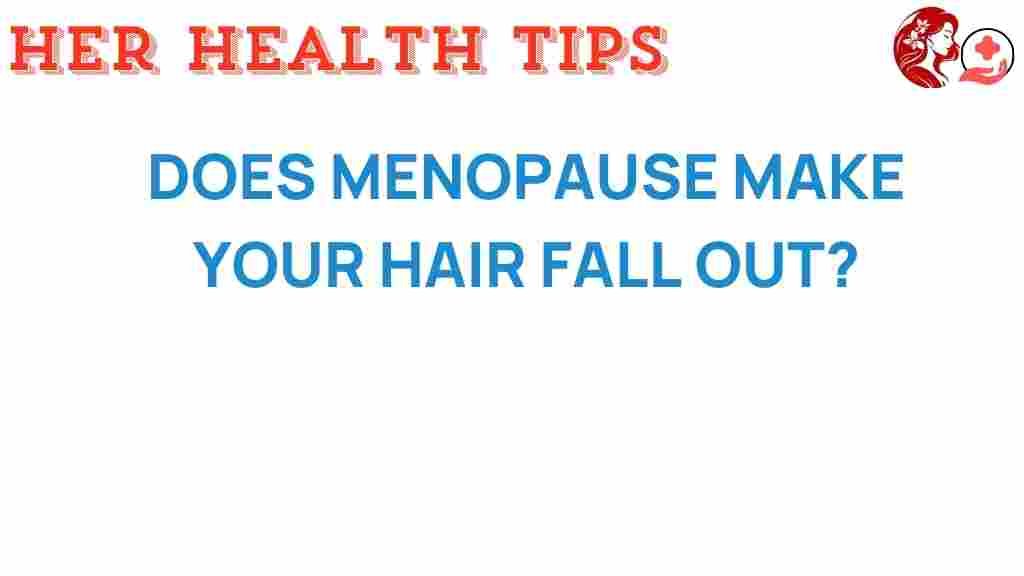Unmasking the Truth: Does Menopause Cause Hair Loss?
Menopause is a natural phase in a woman’s life, marking the end of her reproductive years. However, this transition often comes with various physical and emotional changes, leading many women to wonder about its impact on their overall health, particularly regarding hair loss. In this article, we will explore the connection between menopause and hair loss, the underlying hormonal changes, and practical tips for maintaining healthy hair during this phase of life.
Understanding Menopause and Its Effects
Menopause typically occurs between the ages of 45 and 55, and it can bring about significant changes in a woman’s body. The primary cause of menopause is the natural decline in reproductive hormones, particularly estrogen and progesterone. This hormonal shift can affect many aspects of women’s health, including skin elasticity, bone density, and hair growth.
How Hormonal Changes Lead to Hair Loss
During menopause, the decrease in estrogen levels can lead to thinning hair and hair loss. Here’s how hormonal changes contribute to these issues:
- Estrogen Levels: Estrogen promotes hair growth and helps keep hair follicles healthy. When estrogen levels drop, it can lead to a slower growth cycle for hair.
- Androgens: The balance between estrogen and androgens (male hormones) shifts during menopause. Increased levels of androgens can result in hair thinning, particularly on the scalp, while sometimes causing excess hair growth in other areas.
- Thinning Hair: Hair follicles may become smaller, leading to finer hair strands and increased shedding.
Is Hair Loss Common During Menopause?
Yes, hair loss is a common concern among women experiencing menopause. According to studies, approximately 40% of women report noticeable hair thinning during this transitional period. While this can be distressing, it’s essential to understand that it is a normal part of aging and hormonal changes.
Identifying Thinning Hair
It’s crucial to recognize the signs of thinning hair to address the issue effectively. Look out for:
- Wider Parting: An increase in the width of your hair part can indicate thinning.
- Excessive Shedding: Finding more hair strands on your pillow or in the shower can be a sign of hair loss.
- Visible Scalp: A more visible scalp, especially in areas where hair was once denser.
Step-by-Step Process to Manage Hair Loss During Menopause
Managing hair loss during menopause requires a holistic approach focused on women’s health, beauty, and wellness. Here’s a step-by-step guide:
Step 1: Evaluate Your Diet
Your diet plays a significant role in hair health. Consider incorporating:
- Protein: Essential for hair growth. Include lean meats, fish, eggs, and legumes.
- Omega-3 Fatty Acids: Found in fish, flaxseed, and walnuts, these can promote scalp health.
- Vitamins and Minerals: Ensure adequate intake of vitamins A, C, D, E, and minerals like iron and zinc.
Step 2: Maintain a Healthy Scalp Care Routine
Healthy scalp care is vital for hair growth and maintenance. Here are some tips:
- Gentle Cleansing: Use a mild shampoo to avoid stripping natural oils from your scalp.
- Regular Massages: Scalp massages can stimulate blood flow and promote hair growth.
- Moisturizing: Keep your scalp hydrated with natural oils like coconut or argan oil.
Step 3: Consider Supplements
Some women find that taking supplements can help combat hair loss. Look for:
- Biotin: Known to improve hair health and strength.
- Collagen: Supports hair structure and promotes growth.
- Hormonal Balancers: Consult with a healthcare provider about supplements that may help balance hormones.
Step 4: Explore Hair Care Products
Choose hair care products designed for thinning hair. Look for:
- Thickening Shampoos: These can add volume and make hair appear fuller.
- Hair Serums: Formulations containing minoxidil may promote hair regrowth.
- Heat Protectants: Protect your hair from styling tools that can cause damage.
Step 5: Consult a Professional
If you’re experiencing significant hair loss, consider consulting a dermatologist or a trichologist. They can assess your hair and scalp health and recommend appropriate treatments.
Troubleshooting Tips for Hair Loss During Menopause
While managing hair loss can be challenging, here are some troubleshooting tips:
- Manage Stress: Stress can exacerbate hair loss. Engage in relaxation techniques such as yoga, meditation, or deep breathing exercises.
- Stay Hydrated: Drinking plenty of water is essential for overall health, including hair health.
- Avoid Harsh Treatments: Limit chemical treatments and heat styling to reduce damage to hair.
Conclusion: Embracing Change with Confidence
Menopause can undoubtedly bring challenges, including hair loss, but it is essential to understand that these changes are a natural part of aging and hormonal shifts. By adopting a proactive approach to women’s health, focusing on scalp care, and embracing beauty and wellness practices, you can manage thinning hair effectively.
Remember, every woman’s experience with menopause is unique, and what works for one may not work for another. It’s vital to listen to your body and seek professional advice when needed. With the right strategies in place, you can embrace this new chapter of your life with confidence and grace.
For more information on women’s health and wellness during menopause, visit this resource.
Explore additional tips for maintaining hair health at this article.
This article is in the category Conditions and created by HerHealthTips Team

1 thought on “Unmasking the Truth: Does Menopause Cause Hair Loss?”